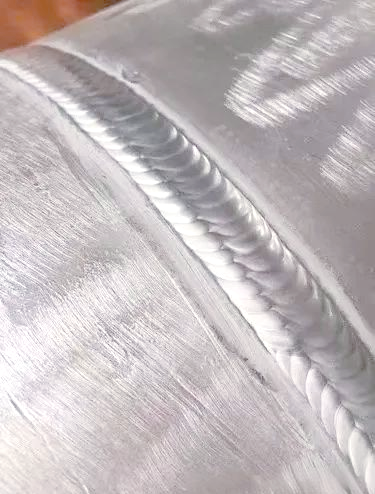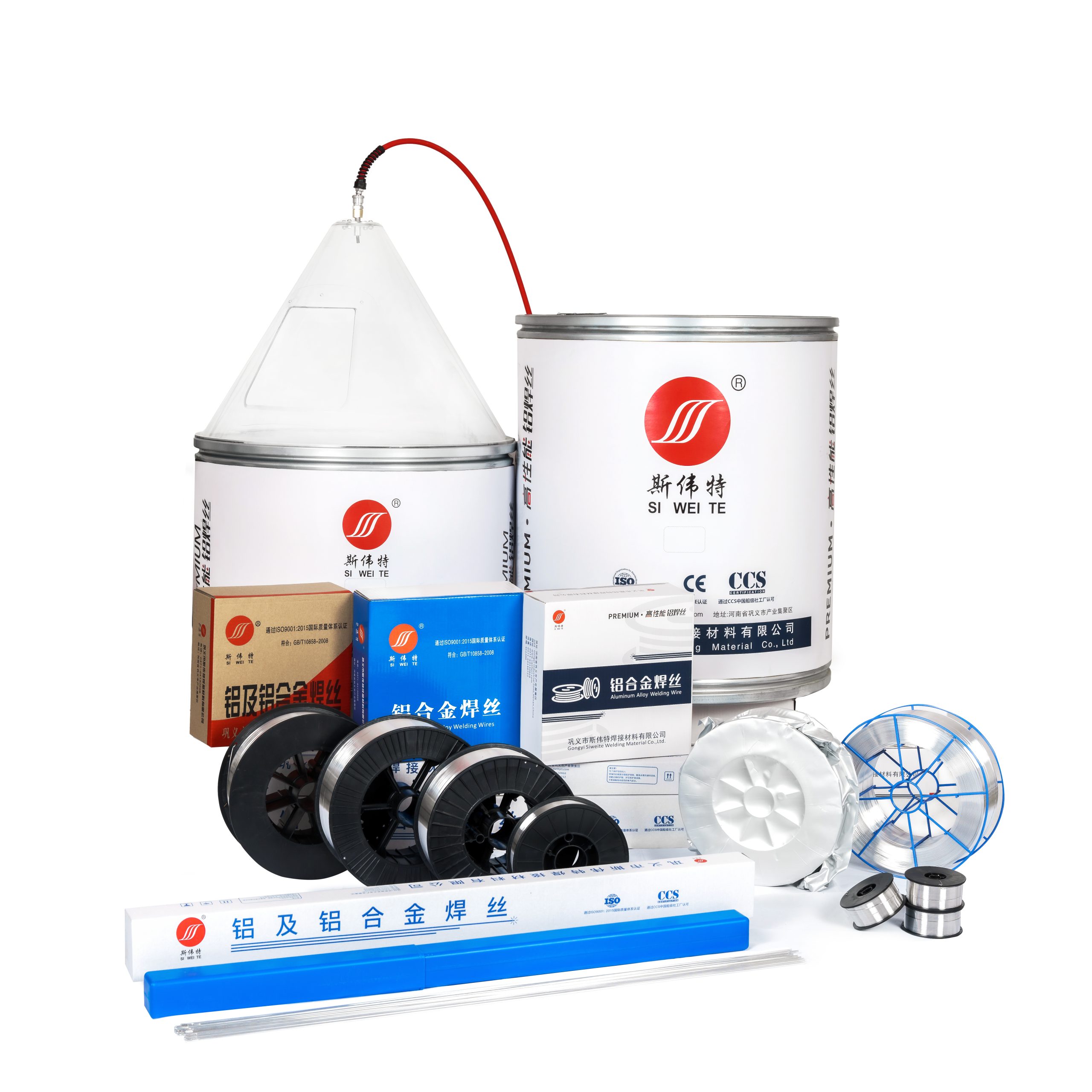Uneven or blocked wire feeding is a common issue in aluminum welding, which not only disrupts the welding process but also directly affects weld quality. Often, a single weld seam has to be completed in multiple sections, leading to inefficiency and potential defects. This article analyzes 9 main causes of aluminum welding wire feeding problems and provides practical solutions to help you achieve smooth, high-quality welding.
1. Hard Bends in Aluminum Welding Wire
Causes
Aluminum welding wire does not have hard bends during production. Hard bends usually occur when the wire spool is damaged or dropped during transportation, causing the wire to scatter. They can also form when scattered wire is manually rewound onto the spool without proper care.
Symptoms
Wire with hard bends may get stuck before entering the welding torch—either in the wire feeder or the wire feeding hose. If it does reach the contact tip, it can block the tip or even burn it out when the welding current or voltage is too high.
Solutions
- Inspect the wire spool carefully before use. Ensure the spool is intact and the wire is neatly wound.
- Handle wire spools gently during transportation to avoid dropping or collision.
- When rewinding scattered wire, wear gloves and maintain a steady, even tension to prevent hard bends.
2. Rust on Aluminum Welding Wire
Causes
Rust on aluminum welding wire typically results from damaged packaging during transportation, high humidity in the storage area (exceeding the recommended level), long-term storage, or contact with human hands (due to oil and moisture) before storage.
Symptoms
Rusty wire causes the feeder’s pressure wheel to slip, disrupting normal feeding. The rust increases the wire’s diameter, leading to blockages in the contact tip. This not only stops welding but also may burn the contact tip at high current. Additionally, rusty wire results in poor weld appearance with surface impurities.
Solutions
- Check for rust before opening the wire package. Replace rusty wire immediately.
- Ensure the storage area for aluminum welding wire has controlled humidity. Store wires at least 300mm away from the ground and walls.
- Follow the “first-in, first-out” principle for wire usage. Avoid touching the wire with bare hands after opening the package.
3. Uneven Diameter or Burrs on Aluminum Welding Wire
Causes
This issue stems from substandard wire-drawing equipment during the aluminum welding wire production process.
Symptoms
Wire with uneven diameter or burrs rubs against the inner wall of the welding torch’s feeding hose, causing vibration. As the wire moves toward the contact tip, this vibration leads to unstable feeding, intermittent welding, or complete jamming.
Solutions
If intermittent welding persists after replacing the contact tip, use a matching contact tip to test the wire. If the wire (before passing through the feeder’s pressure wheel) cannot pass through the matching contact tip smoothly, the wire diameter is uneven—replace the wire immediately.
4. Improper Use of Wire Feeder Pressure Wheel
Causes
The pressure wheel must match the type of aluminum welding wire: use steel wheels for solid aluminum wire and ceramic wheels for flux-cored aluminum wire. Additionally, the wheel groove size must match the wire diameter, and the pressure must be adjusted correctly (neither too loose nor too tight).
Symptoms
- Using a ceramic wheel for solid aluminum wire accelerates wheel wear.
- Using a steel wheel for flux-cored aluminum wire crushes the wire, causing the flux to leak and making welding impossible.
- If the wheel groove is smaller than the wire diameter, the wire becomes deformed (with indentations) and may get stuck in the contact tip.
- If the wheel groove is larger than the wire diameter, the wheel slips due to insufficient friction, leading to poor feeding.
- Excessive pressure deforms the wire; insufficient pressure causes unstable feeding when the wire encounters resistance in the hose or contact tip.
Solutions
- Select the correct wheel material (steel for solid wire, ceramic for flux-cored wire) and groove size matching the wire diameter.
- Adjust the pressure to a moderate level. Regularly clean the wheel groove to remove debris.
5. Excessive or Sharp Bends in the Welding Torch
Causes
Excessive bends occur when the torch is used carelessly or when welding in tight spaces that require extreme torch angles.
Symptoms
Sharp bends increase the resistance of the aluminum wire as it moves through the feeding hose, resulting in difficult or unstable wire feeding.
Solutions
Keep the welding torch as straight as possible or use gentle bends during welding. This minimizes resistance and ensures smooth wire movement in the hose.
6. Grooves Inside the Torch’s Wire Feeding Hose
Causes
Long-term use causes the aluminum wire to rub against the inner wall of the feeding hose, creating grooves over time.
Symptoms
When the wire enters these grooves, changes in the torch’s bending angle during welding can trap the wire, blocking normal feeding.
Solutions
- Replace the feeding hose if you notice uneven feeding, vibration in the hose (near the torch handle), or jamming when adjusting the torch angle.
- Maintain gentle torch bends to reduce friction between the wire and the hose.
- Ensure the hose length matches the torch model—too short causes the wire to bend inside the torch; too long creates extra bends and increases resistance.
7. Unclean Contact Tip
Causes
Welding spatter adheres to the contact tip when the welding parameters are improperly set or the torch is too close to the molten pool. The spatter accumulates with prolonged welding.
Symptoms
Excessive spatter blocks the contact tip’s wire hole, increasing feeding resistance and causing jamming.
Solutions
- Set the correct torch angle and wire extension length to reduce spatter.
- Regularly clean spatter from the contact tip using needle-nose pliers.
- After cleaning, extend the wire 10-15cm from the tip. Bend the wire at the tip’s base and rotate it 3-5 times (clockwise or counterclockwise), then release it. The wire’s rebound will smooth the tip’s hole.
8. Worn-Out Wire Hole in the Contact Tip
Causes
Long-term friction from the aluminum wire enlarges the contact tip’s wire hole over time.
Symptoms
A worn hole causes poor electrical conductivity, leading to arcing between the wire and the tip. This results in unstable feeding, wire-tip adhesion, and wire wobble in the molten pool—all of which damage weld appearance.
Solutions
- Replace the contact tip immediately if you notice wire wobble, adhesion to the tip, or uneven welds.
- Use a contact tip that matches the aluminum wire diameter—too small causes jamming; too large leads to wire wobble.
9. Mismatched Welding Current and Voltage
Causes
Mismatched parameters result from incorrect setup of welding specifications or lack of experience in adjusting current and voltage.
Symptoms
- High current with low voltage causes intermittent welding, excessive spatter, and loud, erratic wire transfer to the molten pool.
- Low current with high voltage produces excessive smoke, weak wire transfer sounds, and wire-tip melting/adhesion—making welding impossible.
Solutions
Adjust the current and voltage according to the recommended welding specifications for aluminum wire. The goal is to ensure the wire melts evenly as it enters the molten pool, with a steady, uniform wire transfer sound.
If you have encountered other aluminum welding wire feeding problems or have unique solutions, feel free to share your experiences in the comments section below!





